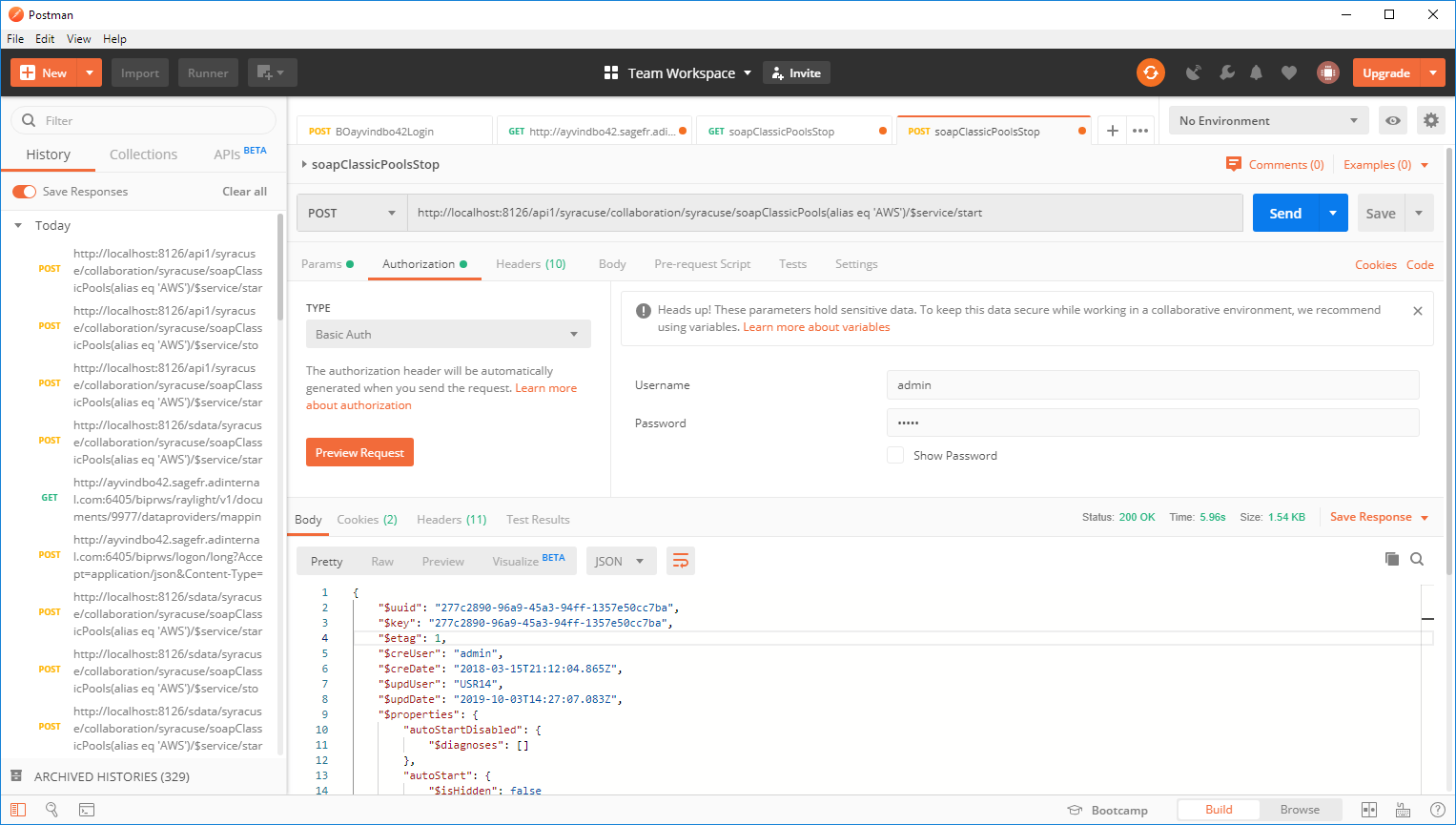Classic SOAP pools configuration
| Administration Page | Application/Contract | Syracuse/Collaboration | Class | soapClassicPools | Representation | soapClassicPool |
|---|
A classic SOAP pool configuration is a pool of connections that allows a SOAP client to connect to SOAP Web services via dedicated classic type sessions using the same format as in version 6.
More information about SOAP Web services is available in the following document.
Required information for a classic SOAP pool is as follows:
The name of the pool that is used in each Web service call context.
Represents the maximum number of clients (per node.js process) that can be started on this pool. A new client is started only if all clients are busy.
For example, if you set maximum size to 10, and the Syracuse load balancer host is set to 3 Web services processes, 30 clients can be used if necessary.
Represents the number of clients (per node.js process) that are initialized during the pool startup.
For example, if you set initialization size to 5, and Syracuse load balancer host is set to 3 Web services processes, then 15 clients will be initialized during the pool startup.
If you set the initialization size above 8, you might get a timeout error during the start or stop of the Web service pool. In this case, increase the return request timeout value.
Sets the pool startup to automatic. The pool starts at the time the Syracuse server starts and restart after a pool failure.
Enter a list of tags, separated by commas, to change the assignment policy of runtime servers. According to this policy: Only users within a group whose group tag is included in the list on a runtime server can connect to Web services. In the Classic SOAP pool configuration, this list is associated with the SOAP pool user and takes precedence over the user's group list. If no tag from this list is associated with an available runtime server, then the default round robin rule applies.
Sets the endpoint used for every Web service requests.
Sets the language used for channel initialization; this can be changed by the Web service call context.
Sets the user considered for channel initialization; this can be changed by the Web service call context.
Allows you to start or to update the pool. If channels already exist, and size or context information have changed, each channel is updated.
For example:
* If the initialization size changes from 10 to 5, calling update service destroys 5 clients.
* If the initialization size changes from 5 to 10, calling update service creates 5 more clients.
* If the endpoint changes, calling update service destroys and recreates all clients, connecting them to the appropriate X3 server.
* If the locale changes, each client is updated with the new language.
* If the user changes, each client is updated with the new user.
* Note: you can have any combination of these examples.
Important: make sure that the host entity is correctly set up with dedicated web sessions, otherwise the start operation will fail with a message that tells that the host setup is not correct.
Provides information on current state of the pool.
The popup view displays one line per node.js process.
* Index mode: displays only one line where host is the server name and the port is 8124 (if the port used is 8124).
* Nanny mode: displays one line per node.js process where host is the server name and the port is W0, W1, W2, ... Wn.
Each line retrieves a summary of information: max size, init size, and auto start. It also includes Nb clients created and Nb clients available.
When expanding the line, additional client information is available:
You can use the REST Web service to start and stop pools. This can be useful in cases where you can't use the user interface.
You need to use a POST http request with an attached Authorization information.
POST http://[SyracuseHost]:[PORT]/api1/syracuse/collaboration/syracuse/soapClassicPools(alias eq '[POOL NAME]')/$service/startAuthorization: [Basic / BearedToken ]
The /API address doesn't consume any badge. Neither does the /SDATA address.
POST http://localhost:8124/api1/syracuse/collaboration/syracuse/soapClassicPools(alias eq 'AWS')/$service/startAuthorization: Basic YWRtaW46YWRtaW4=
Note: You need to enter the Authorization header to add the user name and password.

POST http://localhost:8124/api1/syracuse/collaboration/syracuse/soapClassicPools(alias eq 'AWS')/$service/stopAuthorization: Basic YWRtaW46YWRtaW4=
GET http://localhost:8124/api1/syracuse/collaboration/syracuse/soapClassicPools?representation=soapClassicPool.$query
"$resources": [{"$url": "/sdata/syracuse/collaboration/syracuse/soapClassicPools('6124f8ce-b972-4d57-8ab2-f84b95a260f3')?representation=soapClassicPool.$details","$shortUrl": "/sdata/syracuse/collaboration/syracuse/soapClassicPools('6124f8ce-b972-4d57-8ab2-f84b95a260f3')","x3serverTags": "","autoStartDisabled": false,"autoStart": true,"initSize": 2,"maxSize": 2,"alias": "AWS",}]